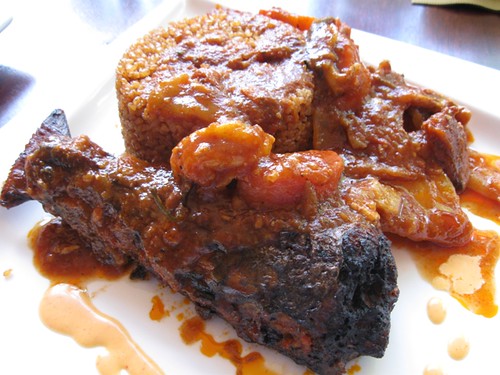
Photo: SToppin/Flickr
Emma Jacobs
Janet Clarkson is The Old Foodie. She blogs regularly on historic recipes and eating habits from her modern kitchen in Brisbane, Australia. Clarkson is also the author of Pie: A Global History. She agreed to answer some questions from Public Radio Kitchen about how she got interested in old food, and the highlights of 17th-century cookbooks.
***
I have been interested in food (cooking and eating it, that is!) as long as I can remember. I hated history at school. I just found myself reading more and more about it and, without consciously setting out to be a food historian, that is where I arrived.
PRK: Do you cook historic food often? What was the first item you tried to make?
I actually don’t cook [it] very often. It is more of an academic interest for me. To cook historic food faithfully requires an historic kitchen. Old methods are just as important to the final outcome as the recipe ingredients and instructions themselves. One of the problems (challenges) in cooking old recipes is that instructions in old books are very vague – quantities, times, temperatures, etc., are rarely mentioned, partly because kitchens did not have clocks, thermometers, scales, etc., – cookery methods were dependent on the experience of the cook.
The first recipe I did make was a 14th-century English dish of braised fennel with ginger and other spices. It was delicious.
For me, the interesting thing is to use the past to inspire the present. So many old recipes sound very innovative today, such as a 16th-century recipe for turkey with raspberries, or one for chicken with pears. I am surprised that more chefs and cooks don’t use historical ideas in this way. There is really nothing new under the sun. If you look hard enough, you will always find a similar idea that has been ‘forgotten.’ The 1970’s ‘chicken with forty cloves of garlic’ is not all that different from a medieval recipe.
PRK: How hard does it turn out to be to adapt these recipes? How edible do most turn out?
As I said, because of the very sketchy instructions in most old books, a lot of guesswork is always involved in trying them out today. We can never be completely sure we have made a dish in the same way as it would have been when the particular cookbook was written. It is not so much that dishes made from historic recipes are inedible, but more that tastes change – we probably don’t particularly want the heavy suet puddings of Victorian times anymore. There are, however, some amazingly elegant dishes, including for such things as salads in 17th-century books, so we could probably look to these again for inspiration.
PRK: Have our tastes changed very much?
There has always been a desire for fine, good quality food – but yes, our particular preferences have changed, I think. We don’t value offal, for example, on the whole but once upon a time, when nothing was wasted, nothing was rejected either.
PRK: Where do you look for vintage recipes? Any favorite cookbooks?
I have a lot of old cookbooks myself. I have several hundred, I suppose, both modern and historical in spite of regular culling. But the really old ones (dating back to medieval times) are in online databases. Over the last few years there has been an explosion in the number of historic cookbooks that have been made freely available over the Internet, thanks to such organisations as Google Books, Gutenberg and the Internet Archive, as well as a lot of libraries around the world. I am gradually putting together a list of these books and, when it is ‘done’ (it will never be ‘finished’), I will make it available to anyone who wants it. Sometimes I troll newspaper archives, too, for recipes and advertisements.
I have a number of favourites – too many to call them favourites, I think! A few of them are: The Accomplish’t Cook by Robert May (1660); Eliza Acton’s Modern Cookery for Private Families (1845) – she was the first cookery book writer to list the ingredients separate from the method; and for sheer range and quirkiness I also love Domestic Economy for Rich and Poor by A Lady (1827)
PRK: Any favorite edibles? Or recommendations for Spring?
In Spring – bring back some of the fine 17th-century salad ideas, perhaps!













